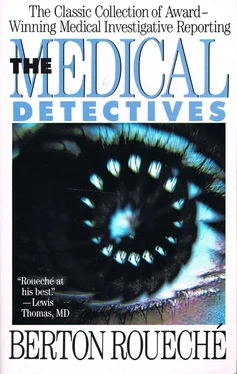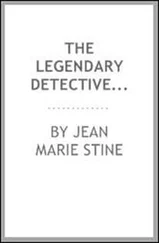"I spent three days on the Vineyard. Ed Brink, a fellow E.I.S. officer assigned to the Connecticut Health Department, came over from Hartford, and we divided up the work. Our job was to get a standard epidemiological study under way. That involved two approaches. One was a study of the Lord cottage and its environment. The other was to determine the dimensions of the outbreak. Was it confined to the seven members of the houseparty, or were they part of a larger epidemic. Alex drove me over to the cottage. I don't know if you know Martha's Vineyard. It's roughly triangular in shape, about twenty miles long from east to west, and from two to ten miles wide. The chief town is Edgartown, at the east end, and the hospital is there. The Lord cottage is at the west end, facing the ocean across an inlet called Chilmark Pond. The Chilmark area is largely rural—hilly, with scrub woods and brush. Patsy and Tom Hooper were still on the Vineyard, and we talked to them at the cottage. Here's what we learned: The nearest neighbor was another summer cottage, about two hundred yards distant, and the two houses shared a well. There had been no illness of any kind at the neighboring house. The Lord party stayed pretty close to its cottage. The only outside activity in which all seven people participated was an annual Vineyard affair called 'The Illumination,' at Oak Bluffs, at the northeast end of the island. We went through the house—large living room with a fireplace, kitchen, bedrooms, and bath. The house is heated when necessary by the fireplace, and the fireplace is equipped with a device called a Heat-o-Lator, which distributes the hot air. The fireplace was used only once during the houseparty week—on the night of August 2. There was nothing significant in the food eaten during the week. The party often went swimming, and waded across the shallow, brackish Chilmark Pond to get to the ocean beach. The Hoopers had two dogs—a Labrador and a Chesapeake Bay retriever—both young and active. Mice had been seen in the cottage early in the season. Rabbits were abundant in the area, and so were ticks, mosquitoes, and flies. During the week of the gathering, the septic tank backed up, but did not overflow. A moldy wooden post supporting the front porch had collapsed early in the week—and moldy wood suggests fungus. We took samples of the pond water, samples of the rotten log, samples of earth at the septic tank, samples of household dust, samples of debris from the Heat-o-Lator, and a sample of drinking water from the kitchen tap. We hadn't picked up anything of much importance. But maybe the laboratory in Atlanta would.
"The other phase of the investigation was hardly more productive. We talked to all the Vineyard doctors, and we burned the midnight oil at the hospital checking out their records. The records in the emergency room showed that four thousand three hundred and ninety-four persons were seen there during July and August of 1977. In the same period of 1978, the number was four thousand three hundred and seventy-three. No leads there. Then we checked admissions. We came up with three patients in 1977 who had been admitted and subsequently discharged with a diagnosis of pneumonia. The total for the period in 1978 was six, of which one was Patsy Lord Hooper. We ran down the five other patients and arranged for blood samples. One of the few positive findings was that there seemed to be no possible connection between the activities of the Lord group and the five other pneumonia patients. And those five were also unconnected. So the indications were reasonably clear that we were dealing with an outbreak concentrated at the Lord cottage. The only really encouraging news came from Colorado. Dan Stafford was off the critical list. He was still very sick, still in intensive care, but they had taken him off the respirator. We couldn't take much credit for that."
Dr. Teutsch's arrival on Martha's Vineyard had been noted in a front-page story in the biweekly Vineyard Gazette on Tuesday, August 29. The story, written by an industrious reporter named Mary Breslauer, was headed:
EPIDEMIOLOGISTS WILL PROBE CHILMARK FAMILY'S ILLNESS Three days later, on September 1, on the eve of Dr. Teutsch's departure, the results of the investigation were also given front page prominence. The story, also the work of Mary Breslauer, was headed:
EPIDEMIOLOGISTS STILL BAFFLED BY CHILMARK FAMILY'S ILLNESS It began: "To the investigating federal epidemiologists, the attending Island physician, and the affected family, the respiratory illness which blighted a Chilmark summer vacation is a medical mystery. . . ."
And ended: " 'We don't know what is going on here,' Dr. Teutsch added. 'It's not a classical presentation of anything at this point, including Legionnaire's disease. We don't know much about Legionnaire's, and it probably has a very broad spectrum, like most diseases. What's happened here is consistent with Legionnaire's, but it's not something that jumps out at us. Nothing is obvious to us yet.' "
"Oh, yes," Dr. Teutsch says. "That's the way it was. We were very definitely thinking of Legionnaire's disease. It had always been Alex's first choice, and Ed and I were quite willing to go along. So was everybody in Atlanta. It was at the top of everybody's list. An attack rate of one hundred per cent is most unusual—seven people, seven illnesses. It means a highly infectious organism, and Legionella pneumophila is that kind of organism. But then the first serologic results came through from our laboratory. We had ordered the tests in order of probability, and the first results were for Legionnaire's. And they were negative. Well! The next best possibility on our list was mycoplasmal pneumonia. Those results were also negative. Well, that was interesting, too. I think the next results were on psittacosis. Negative. So were the tests for influenza A and B. And adenovirus infection. And respiratory syncytial virus disease. And parainfluenzas 1, 2, and 3. And the fungus infections. That left only tularemia. And tularemia seemed to be it. The first four convalercent blood samples—from the three Hoopers and from Anne Lord Stafford—had very significant tula-remia-agglutinating antibodies. The levels ranged from 1:40 up to 1:640, and three of the patients had readings in the upper range. When the results of the tests on the other three came through—on Lord and Betty Smith and Dan Stafford—it was very much the same. They all had significantly high readings on the tularemia organism. I have to say that those reports left us all a little bit astonished. Tularemia was the very last thing we expected. But that was it. Our epidemic was an epidemic of tularemia."
Tularemia is one of an unpleasant handful of infectious diseases that made their first scientifically recorded appearance in the United States. Its companions in this morbid union include rickettsialpox, babesiosis, Lyme arthritis, St. Louis encephalitis, murine typhus, the several Coxsackie-virus infections, and, of course, Rocky Mountain spotted fever and Legionnaire's disease. Like many of these, its name declares its place of origin. The Coxsackie viruses are native to Coxsackie, New York; Lyme arthritis is a native of Lyme, Connecticut; St. Louis encephalitis was first identified in St. Louis and environs; Rocky Mountain spotted fever is the now widely travelled native of the Continental Divide; and Legionnaire's disease made its disastrous debut at the American Legion's 1972 convention in Philadelphia. Tularemia was first recognized as a specific disease in Tulare County, in south-central California, in 1911. ("Tulare" derives from the Spanish tule , a kind of reed that grows abundantly in California—so abundantly that "out in the tulies" has the same meaning in California that "out in the boondocks" does elsewhere.) The discoverer of tularemia was a United States Public Health Service investigator named George W. McCoy. "During the routine examination of ground squirrels," McCoy noted in a report to the Public Health Bulletin in April, 1911, "we have encountered an infection the lesions of which are readily mistaken for those of plague." This slippery new infection, he further noted, had been transferred to healthy squirrels, guinea pigs, domestic rabbits, rats, mice, and a monkey, and "attempts to grow the causative organism are still being made." His conclusion was a muted warning: "We do not know whether the organism causing this disease is pathogenic for man, but judging from the large number of species that are susceptible, we are inclined to suspect that man might contract the infection." The following year, his attempts to grow the organism were finally successful, and he and an associate, C. W. Chapin, announced its laboratory generation under the name of Bacterium tularense , from which (at the suggestion of Edward Francis, a celebrated bacteriologist and 1928 Nobel Prize nominee, who largely completed the elucidation of the disease) tularemia in turn derived its name. A year later, in 1913, Bacterium tularense confirmed McCoy's natural suspicions and felled its first recorded human victim—a meat-cutter in a Cincinnati restaurant specializing in wild-rabbit dishes; he is known to medical history only as "E. E." The historic diagnosis of E. E.'s illness (fever, prostration, a plaguelike lesion), and its subsequent substantiation by a perspicacious professor of bacteriology at the University of Cincinnati named William H. Wherry, was somewhat more than the mere premiere of human tularemia. It led to the identification, as tularemia, of a long-puzzling occupational complaint called variously "market-men's disease" and "meat-cutter's disease" and, most commonly, "rabbit fever," and it also established the wild cottontail rabbit as the chief source of the infection in human beings. It was, in fact, the threat of tularemia that eventually led most American municipalities to restrict the sale of wild rabbits as food.
Читать дальше












